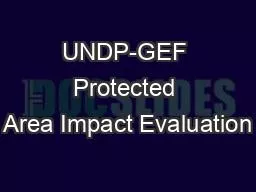

INDEPENDENT EVALUATION OFFICE 19 October 2017 NEC Conference Istanbul PA Impact Evaluation State of the art science and methodology Portfolio analysis of completed projects Forest change gt ID: 795301
Download The PPT/PDF document "UNDP-GEF Protected Area Impact Evaluatio..." is the property of its rightful owner. Permission is granted to download and print the materials on this web site for personal, non-commercial use only, and to display it on your personal computer provided you do not modify the materials and that you retain all copyright notices contained in the materials. By downloading content from our website, you accept the terms of this agreement.
Slide1
UNDP-GEF Protected Area Impact Evaluation
INDEPENDENT EVALUATION OFFICE
19 October 2017
NEC Conference, Istanbul
Slide2PA Impact Evaluation
State
of the art science and
methodology:
Portfolio analysis of completed projects
Forest change -> remote sensing dataSpecies population abundance by trend analysis before and after supportHuman interaction with PAs using case studies from field visitsTrends in capacity and governance in PAs & PA systemsManagement Effectiveness Tracking Tool Analysis
IEO
Slide3Portfolio Analysis
Total of 618 projects (137 countries) included in the portfolio
as having interventions in non-marine PAs and PA systems from 1992 to the presentMore than half completed or implemented for at least 6 years68% (415) full size and 32% (191) medium sizeImplementing agencies: UNDP (48%), World Bank (37%), UNEP (9%), and other UN agencies and regional development banks (5%)
Global
Africa
Europe & Central Asia
Latin America & the Caribbean
Asia
GEF Grant
Cofinancing
US$ 2.57 B
US$ 9.70 B
TOTAL FUNDING* > US$ 12.3 B
*excludes 140 projects for which no financial data was available
Slide4Global Analysis
838 confirmed GEF-supported PAs in
WDPA databaseAnother 27,995
Non-GEF
PAs used to estimate counterfactual
Slide5PA
PA – 10km
PA – 25km(excluding the inner)
Percent Tree Cover (%)
Percent Tree Cover (2000)
Forest Cover Change Analysis
%
Percent Forest Loss (%)
Year (1:2000-2001, …, 12: 2011-2012)
Yearly Percent of Forest Loss (2000 – 2012)
Decadal Forest Cover, Gain and Loss (2000 – 2012)
Cumbres
de Monterrey,
MEXICO
Slide6Wildlife Abundance Change Analysis
A time series showing a clear change in population trend of
Tana River Red Colobus
after the GEF project started in
Tana Reserve, KenyaRed dashed line shows start of GEF support, blue lines show population trendGEF project objective consistent with observed outcomeBefore / After GEF interventionSpecies: Cercocebus galeritus (Tana River Red Colobus)Red List Category &
Criteria: Endangered C2a(ii) ver 3.1
Slide7Species richness study
Is GEF supporting areas of high biodiversity?
Pimm
, SL et. al (2014)
Science
344 (6187): 1246752Mexico: Threatened Mammals richness
Species-rich areas in Mexico vs. PA locations
Slide8Management Effectiveness Tracking Tool (METT)
2440
METTs
from
1924 GEF supported PAs
Covering 107 countries275 PAs with
time series
data
METTs
analyzed
for:
Compliance
and completeness
Scores and quality of assessments
Overall difference between GEF
and non-GEF assessments
Global Distribution of METT Forms
Slide9MEXICO
COLOMBIA
UGANDA
NAMIBIA
INDONESIA
VIETNAMKENYA
CASE STUDY ANALYSIS
3 REGIONS ◊ 7 COUNTRIES
◊
28 PAs
Slide1010
Qualitative Comparative Analysis (QCA)
Cases: 28 PAs
Outcome: DECREASE IN TRENDS IN ILLEGAL ACTIVITIES
Cases: 7 countries
Outcome: FUNCTIONAL PA SYSTEMFindings assed which combinations of factors are most important for producing observed outcomes:biodiversitymanagement effectivenesscommunity engagementUses set theory rather than probabilistic methods
Slide11Limitations & Remedies
11
Slide12Results / conclusions
When GEF links long term engagement, financial sustainability, and the use of multiple approaches, stakeholders and scales,
greater
adaptability and higher likelihood of broader
adoption follows.
GEF support has helped build capacities to manage protected areasGEF has helped to lower habitat loss, however loss of global biodiversity continues at an alarming rate!